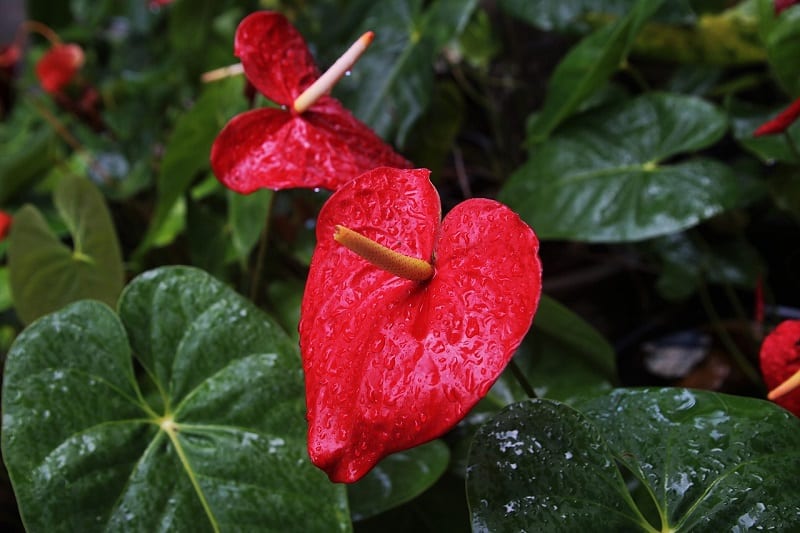Anthurium Flower is a genus of American tropical herbaceous plants, which comprises approximately 825 species of the Arum family
The name of the genus comes from the Greek words anthos of “flower” and oura which means “tail”, which refers to the tail-shaped spadix. Being this plant native to South America, Mexico and the Caribbean.
Anthurium Characteristics
It is widely cultivated for the florist trade for its showy and long-lasting flowers. Common names for these plants are flamingo lily, tongue of fire, flor de cola or painter’s palette.
Anthuriums flower develops in bright colors and a wide variety of shapes.
The flowering varieties of these plants are distinctive for their multi-colored spathe and bright red or yellow flower-shaped spike tails. Other varieties feature large leaf foliage and deep veining.
The Anthuriums flower can appear throughout the year in optimal growing conditions.
They are generally collector’s plants and many of the more lavish varieties are rarely found outside of greenhouses and botanical gardens.
Varieties
Anthurium andreanum
These feature heart-shaped leaves that grow to about 30 centimeters, with flowers available in red, white, pink, and mixed colors. They are distinguished by a straight beak of flowers.
Anthurium scherzerianum
It is the most forgiving anthurium, featuring a curling orange flower beak and arrow-shaped leaves.
Anthurium crystallinum
They have velvety, dark green leaves with pronounced white backs. The leaves grow up to 60 centimeters wide.
Anthurium faustinomirandae
A large plant with stiff, cardboard-like leaves that grow to 150 centimeters long. This is almost exclusively a greenhouse plant.
These plants are not only decorative, but many are also natural air filters that work to clean the interior environment, absorbing irritating or harmful chemicals from the air, and Anthuriums are a natural filter for ammonia and xylene.
However, be careful with the sap and leaves of the plant, they can cause allergies in sensitive people and pets.
How to care for the Anthuriums flower
To better propagate the Anthurium flower, divide the plant while transplanting it or take cuttings from the tip or stem.
Old foliage plants have many exposed aerial roots and overgrow in their pots.
These exposed roots can be cut at ground level and placed in new containers.
From those roots stems will grow and then leaves will emerge. These plants can be transplanted annually if they have grown too big for the pot. Use high-quality potting soil.
Anthuriums plants thrive in bright, indirect light. They don’t like exposure to direct sunlight except in the winter months or on plants that have been carefully acclimatized.
It grows in rich, loose soil that must be kept moist at all times, but not soggy.
Dead flowers, old, yellowed leaves should be cut, because after the leaves and flowers fade, they don’t recover again. Anthurium will only produce new leaves and flowers.
It must be sprayed in spring and summer with any general-purpose fertilizer suitable for houseplants.
Diseases and pests, when the plant has brown leaves and leaf it is receiving too much or too little water.
Before giving water, feel how wet the potted soil is. If it feels quite dry, the plant needs a little water, but if the soil is wet, wait a week before watering it again.
If the leaves are yellowish, the Anthurium flower is probably getting too much sunlight and you need to keep it away from where it is.
If new flowers are born, but they are not green, then it may be receiving very little light and needs you to move it closer to the window.
There are no serious insect or disease problems, however, keep an eye on mealybugs, mites or whiteflies.
If the leaves turn yellow, wilt and fall, the plant is surely being affected by a cold draft, so move it to a much warmer place.
On the other hand, if the roots protrude from the pot, you will have to change the Anthurium to a much larger pot; And, if the new leaves are very small or the flowering is very little, you will have to renew the soil and fertilize.
Conclusion
The Anthurium flower is native to South America, Mexico and the Caribbean which is mainly used indoors due to its exotic and powerful reddish colors, ideal for decorating any environment.
There are approximately 825 species of this plant and each one has its own special care.
Although the anthurium is beautiful and indicated to have it inside the house, the care it requires is quite specific, however, it is not at all complicated.
